-

人教版新目标初中英语八年级下册What should I do教案2篇
说明:在帮Li Lei提建议的同时,教育学生如何学好英语。第三课时教学目标1. 语言目标:a) 词汇: Original, in style, haircut, the same as.b) 语言结构:My friend wears the same clothes and has the same haircut as I do.2. 能力目标:大多数学生能够谈论自己喜欢哪种服装,提高查找信息的能力。3. 情感目标:学会如何与朋友相处,要有自己对时尚的看法。教学重点掌握一些重要词汇。教学难点学会谈论问题,并能提出书面建议。◆教学突破首先针对Erin的问题,提出个人的建议,模仿2c部分的对话展开双人交际Pair-work;听老师诵读3a部分的信件,并找出LEFT OUT的问题所在;学生完成3b部分的内容,给Left Out提出书面的建议;学以口头形式提出自己目前存在的某个问题,讲给大家听,让同学们给自己提出一个建议,并作笔录;学生两、三个人分成一组,随意性地进行口语交际,谈论P14的第4部分的某个问题,相互交换意见。

人教版新目标初中英语八年级上册I’m more outgoing than my sister教案2篇
1 交通工具的比较此活动为小组活动。学生通过讨论找出到达某一城市可乘坐的各种交通工具,并选择最佳出行方式。Teacher:We’re going to Shanghai. How many ways can we use to get there? Yes, there are four ways: by bus, by plane, by train, by ship. Please discuss how you are going to get there.操作建议:(1)学生以小组为单位展开活动,谈论本组所选择的交通工具。(2)各组选代表向全班汇报,阐述本组所选择的交通工具的利和弊。完成任务所需要的语言结构:We can go there by ship. It’s more comfortable and cheaper than any other transportation.We can go there by bus. It’s cheaper but it takes longer time.2 哪个城市更合适?此活动具有挑战性。假设中国要举行2014年世界杯足球赛,分别从历史,人文,天气等方面对各城市(北京,大连,上海,昆明)进行比较,选择最佳举办城市。T: Imagine China is holding the 2014 FIFA World Cup. Which city do you think is the best for the World Cup, Beijing, Dalian, Shanghai or Kunming? Let’s work in groups. If you choose Beijing, please join the Team Red. If you chose Dalian, please join the Team White. If you choose Shanghai, please join the Team Blue. If you choose Kunming, please join the Team Green. Please show us its advantages. Then let’s see which team will win.

人教版新目标初中英语八年级上册What’s the best radio station教案2篇
教学重点和难点:运用所掌握的语言描述,比较不同地点的特点。在练习中学习掌握英语比较级和最高级的用法。课前准备分配小组,每组五至六人。通过上网或翻阅报刊杂志等方法,确定旅游线路,做出基本的旅游计划。教学设计:本节课流程图 学法指导:1.由于这是一堂新课,在教学中应注意面向全体,发挥学生的主体性,引导学生积极参与,激发学生的求知欲和学习积极性,指导学生积极思维,主动获取知识,养成良好的学习方法。逐步学会独立解决问题。总之要尽可能调动学生的非智力因素促进智力因素的发展。教法选择:1.电化教学法2.课堂讨论法3.任务型教学法采用这些方法的目的是为了充分调动学生的学习积极性,使学生变被动学习为主动学习。通过电脑形象的演示,加强印象,提高兴趣,突破难点,提高教学效率,进而增大教学的容量和信息量。充分体现教师为主导,学生为主体的教学原则。

人教版新目标初中英语八年级上册What’s the matter教案2篇
She shouldn’t go to the party tonight.Step7. TaskT: You know, there are lots of problems in our life. If you are a doctor, please tell us how to solve the problem. I will divide you into 9 groups. Please work in groups. And then choose one of you to report your ideas.The following are the problems:I have a toothache.I am hungry. I have a sore throat.I am stressed out. I have a sore back.I am tired. I can’t sleep.I have a cold. I have a headache.Report: If you have a headache, you should go to bed early. You should see the doctor. You should eat some medicine. You shouldn’t wash your face with cold water.You shouldn’t sleep late.You shouldn’t swim.…..T encourages the students to give advice as much as possible.Homework:1. Chose one of the problems, and write down your advice2. Copy the new words这一步是用于热身的,同时也可以让他们复习一部分的表示人体部位的单词,扩充知识.学习语言的过程也是一个不断积累的过程,复习旧知识,增添新知识.通过小游戏,强化学生对Does she/he have…这个句子的运用能力.通过复习,自然的引到下面新知识的学习。充分利用表格,由句子到对话,再到文章,让学生循序渐进. 提高学生的综合语言运用能力,运用以前学过的知识来解决身边的问题.Period 5 (Section B 3a—3c, selfcheck)教学内容与分析:

人教版新目标初中英语八年级下册If you go to the party, you’ll have a great time教案2篇
区分宾语从句、定于从句和状语从句宾语从句和状语从句,都叫做主从复合句。宾语从句主要是中考必考的,是初中阶段必掌握的从句,宾语从句主要是掌握三要素,所谓宾语从句,就是宾语在主从复合句当中充当宾语的一个句子,叫做宾语从句。主句的谓语动词是及物动词,后面如果是词或者是短语的话,是简单句,如果是句子的话,肯定是宾语从句。I know that he good at English.就是宾语从句,三要素,一要素是要注意连词,连词一共学了三类连词,一类连词是that口语当中可以省略,就像刚才说的那一句,I hear he is good at English.还有疑问代词、疑问副词,how where when,疑问代词、疑问副词。还有一类连词weather是否的意思,不是状语从句当中的如果,这一定要和如果区分开,这是是否。I don't know if he interested at English。宾语从句要注意if是连词。第二要素是语序,要用陈述举语序。比如说你家有几口人,我们都说How many people are there in you family?但是这是简单句,一旦说成宾语从句,你可以告诉我你家有几口人吗?Could you tell me how many people there are in you family ?

人教版新目标初中英语八年级下册It’s a nice day, isn’t it教案2篇
"Hello! Welcome to English class! Introduce yourself. Meet your new classmates." That's what the teacher says. What do you say? "Oh no!" It can be difficult talking to new people. But it can be fun, and you can make friends. How do you do it? Make small talk. Small talk is polite conversation. "Wang Nan is a great pingpang player, isn't she?" "I'd love to meet her, wouldn't you?" "It's been raining a lot, hasn't it?" Tag questions are a form of polite speech. To make small talk successfully, you should know how to make them. You should also know what topics to talk about. Try to learn this unit carefully. The next time you're in English class, you'll find out. Making small talk's easy, isn't it? (“你好!欢迎你!请做一下自我介绍。认识一下你的新同学。”通常在课上老师会这样说。你会说什么呢?“噢,不!”与陌生人谈话太困难了。但是这也很有意思,并且你还能交到朋友。你该怎么做呢?闲聊。闲聊指得是礼貌的对话。“王楠是一个很棒的乒乓球运动员,不是吗?”“我希望自己能认识她,你呢?“今年的雨水很多,不是吗?”反意疑问句是一种礼貌用语。为了使得谈话成功,你应该知道怎样去进行闲聊。你还应该知道与不同的人该谈论什么样的话题。认真的学习这个单元吧,下次在英语课上,你会发现与大家展开谈话是一件很容易的事情,不信我们来试试。)

人教版新目标初中英语八年级下册He said I was hard-working教案2篇
This activity introduces some new vocabulary and provide oral practice using the target language.Task 1 . Ask four students to stand in front of the class, and the teacher asks them the following questions as a reporter.1.What are you going to do when you grow up?2.What are you going to do next week?3.What are going to do after school?The students will give different answers, then ask a good student to report what they said.I am going to e a doctor.What did she say?----------She said she was going to be a doctor.I am going to have a party on Friday night.What did he say?-------He said he was going to have a party on Friday night.I am going to do my homework.What did she say ?------ She said she was going to do her homework.I am going home after school.What did she say?-----She said she was going home after school.Say In this unit we are going to learn to use words like to report what someone said.Task 2. Read the instructions. Then ask a student to read the four questions. And write the words on the Bb. Explain what soap opera is.Task 3. Ask the students to Look at the pictures, point out the TV screens in the picture. Ask one girl to read what Marcia said.What did Marcia say? She said She said she was having a surprise party for Lana on Friday night. Repeat the other pictures in the same way.Activity3. Listen and number the pictures in activity 1a.

人教版新目标初中英语八年级下册How long have you been collecting shells教案2篇
Step Ⅱ Show the new words on the screen and teach the new words. Read the new words to students and ask them to repeat.Step Ⅲ 3aThis activity introduces new vocabulary and provides reading practice using the target language.In this activity first look at the four pictures.T: What can you see in the pictures?Ss: Four snow globes.T: Right. There are four snow globes in the pictures. And what are they?Ss: They are a monster, two polar bears, two penguins and a birthday cake.Write these words on the blackboard: snow globe; monster; polar bear; penguin and birthday cake. Read them to the class and ask students to repeat each one. Make sure students understand each word.Use a computer to show the E-mail message on the screen and read the message to students.Get students to read the e-mail on their own, and then draw lines connecting each snow globe and its description.Correct the answers.AnswersA line should connect each snow globe picture with the words that describe it in the letter.Step Ⅳ 3bThis activity provides writing practice using the target language.First review Activity 2a on Page 47.Then ask students to complete the message according to Activity 2a.Some partial sentences are given to students. Write about one person's collection.When students work, walk around the room checking the progress and offering help as needed.When they finish, ask some students to read their messages to the class.

人教版新目标初中英语九年级上册Where would you like to visit教案2篇
The First PeriodⅠ.Teaching Aims and DemandsKnowledge Objects(1) Key Vocabularytiring, educational, fascinating, thrilling, peaceful, exotic, trek, jungle, take it easy, explore, historic, site(2) Target LanguageWhere would you like to go on vacation?I’d like to trek through the jungle, because I like exciting vacations.2. Ability Objects(1)Train students to talk about places they would like to visit with the target language.(2)Train students to describe vacations with different adjectives.(3)Train students' listening skill.3. Moral Object,It′s more interesting to go on vacating somewhere instead of staying at home.Ⅱ. Teaching Key Points1. Key Vocabularytiring, educational, fascinating, thrilling, peaceful, exotic, trek, jungle, take it easy, explore, historic, site2. Target LanguageTalk about different places with the target language.Ⅲ. Teaching Difficult Points1. Describe vacations with different adjectives.2. Talk about different places with the target language.Ⅳ. Teaching Methods1. Teaching by illumination2. Teaching by doing chain drills3. Teaching by pairworkⅤ. Teaching Aids1. A tape recorder2. Some pictures of different places with famous views

人教版新目标初中英语九年级下册We’re trying to save the manatees教案2篇
本单元主要围绕着有关濒临灭绝的动物这一话题,学习了应该怎样保护我们的环境,以及就某一问题展开辩论。目标提示语言目标能够运用所学知识,就某一问题展开辩论。认知目标1、复习一些语法:现在进行时、一般现在时、用used to 表示一般过去时、现在完成时、一般过去时的被动语态。2、学会表达同意和不同意。3、学会以下基本句型:We’re trying to save the manatees.Manatees eat about 100 pounds of food a day.There used to be a lot of manatees.In 1972,it was discovered that they were endangered.Some of the swamps have become polluted.情感目标了解一些濒临灭绝的动物的生活习性和濒临灭绝的原因,教育学生应该如何保护环境。教学提示充分利用多媒体等教学设备,创设与本课话题相关的情境,如各种不同种类的动物、动物园以及有关环境的画画等等。围绕着本单元的教学目标,设计一些贴近学生实际的教学任务,如让学生谈论自己最喜欢的动物,如何拯救濒危动物,如何保护环境等等。让学生根据所学知识,就动物园是否对动物有利以及其他的话题进行辩论。

初中英语说课教案
(二) 教学目标 依据并结合新课程标准提出的基础教育阶段英语课程的总体目标和具体要求,我将本课教学目标设计如下: 知识目标: 让学生掌握其中的重要词汇mind, turn down, not at all等和句式would you mind doing sth? 并能让学生掌握如何运用所学句式提出礼貌请求以及礼貌的向他人道歉。
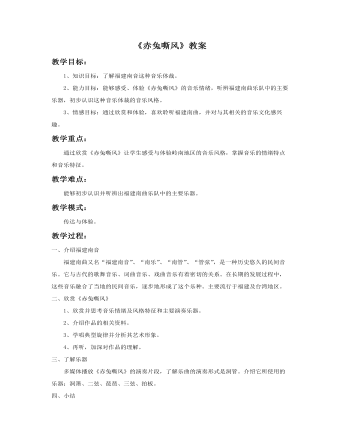
《赤兔嘶风》教案
一、介绍福建南音福建南曲又名“福建南音”、“南乐”、“南管”、“管弦”,是一种历史悠久的民间音乐。它与古代的歌舞音乐、词曲音乐、戏曲音乐有着密切的关系。在长期的发展过程中,这些音乐融合了当地的民间音乐,逐步地形成了这个乐种。主要流行于福建及台湾地区。二、欣赏《赤兔嘶风》1、欣赏并思考音乐情绪及风格特征和主要演奏乐器。2、介绍作品的相关资料。3、学唱典型旋律并分析其艺术形象。4、再听,加深对作品的理解。三、了解乐器多媒体播放《赤兔嘶风》的演奏片段,了解乐曲的演奏形式是洞管。介绍它所使用的乐器:洞箫、二弦、琵琶、三弦、拍板。
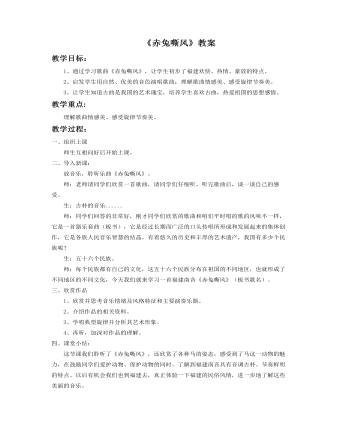
《赤兔嘶风》教案
教学目标:1、通过学习歌曲《赤兔嘶风》,让学生初步了福建欢快、热情、豪放的特点。2、启发学生用自然、优美的音色演唱歌曲;理解歌曲情感美、感受旋律节奏美。3、让学生知道古曲是我国的艺术瑰宝,培养学生喜欢古曲,热爱祖国的思想感情。这节课我们聆听了《赤兔嘶风》,还欣赏了各种马的姿态,感受到了马这一动物的魅力,在鼓励同学们爱护动物、保护动物的同时。了解到福建南音具有音调古朴、节奏鲜明的特点。以后有机会我们也到福建去,真正体验一下福建的民俗风情,进一步地了解这些美丽的音乐。

《洞庭鱼米乡》教案
知识拓展①作曲家白诚仁白诚仁是活跃在上世纪五十年代至八十年代的中国民族作曲家。今天五十岁以上的中国观众大都熟悉他的作品《挑担茶叶上北京》,四十岁以上的观众则对那首《洞庭鱼米乡》耳熟能详,三十岁左右的观众忘不了《小背篓》轻快的旋律。几十年来,白诚仁先生脚踏三湘大地,留下一个一个脚印,走过一个一个山寨,记下一个一个音符,为中国民族音乐宝库奉献出一首首脍炙人口的好作品。 ②洞庭湖洞庭湖,为我国第二大淡水湖,位于湖南省北部,长江荆江河段以南,面积2820平方千米。洞庭湖南纳湘、资、沅、澧四水汇入,北由东面的岳阳城陵矶注入长江,号称“八百里洞庭”。洞庭湖据传为“神仙洞府”的意思,可见其风光之绮丽迷人。洞庭湖浩瀚迂回,山峦突兀,其最大的特点便是湖外有湖,湖中有山,渔帆点点,芦叶青青,水天一色。
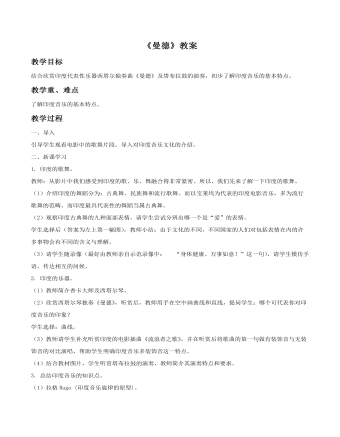
《曼德》教案
一、导入引导学生观看电影中的歌舞片段。导入对印度音乐文化的介绍。二、新课学习1. 印度的歌舞。教师:从影片中我们感受到印度的歌、乐、舞融合得非常紧密。所以,我们先来了解一下印度的歌舞。(1)介绍印度的舞蹈分为:古典舞、民族舞和流行歌舞。而以宝莱坞为代表的印度电影音乐,多为流行歌舞的范畴。而印度最具代表性的舞蹈当属古典舞。(2)观察印度古典舞的九种面部表情。请学生尝试分辨出哪一个是“爱”的表情。学生选择后(答案为左上第一幅图),教师小结:由于文化的不同,不同国家的人们对包括表情在内的许多事物会有不同的含义与理解。(3)请学生随录像(最好由教师亲自示范录像中: “身体健康、万事如意!”这一句),请学生模仿手语,传达相互的问候。
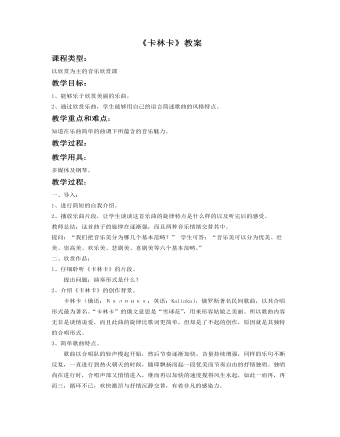
《卡林卡》教案
一、导入:1、进行简短的自我介绍。2、播放乐曲片段,让学生谈谈这首乐曲的旋律特点是什么样的以及听完后的感受。教师总结:这首曲子的旋律在逐渐强,而且两种音乐情绪交替其中。提问:“我们把音乐美分为哪几个基本范畴?” 学生可答:“音乐美可以分为优美、壮美、崇高美、欢乐美、悲剧美、喜剧美等六个基本范畴。”二、欣赏作品:1、仔细聆听《卡林卡》的片段。 提出问题:演奏形式是什么?2、介绍《卡林卡》的创作背景。卡林卡(俄语:Калинка;英语:Kalinka),俄罗斯著名民间歌曲,以其合唱形式最为著名。“卡林卡”的俄文意思是“雪球花”,用来形容姑娘之美丽。所以歌曲内容无非是谈情说爱,而且此曲的旋律比歌词更简单,但却是了不起的创作,原因就是其独特的合唱形式。

《化蝶》教案
故事介绍:在中国西晋时期,青年学子梁山伯辞家攻读,途遇女扮男装的学子祝英台,两人一见如故,志趣相投,遂于草桥结拜为兄弟,后同到书院就读。在书院两人朝夕相处,感情日深。三年后,英台返家,山伯十八里相送,二人依依惜别。山伯经师母指点,带上英台留下的蝴蝶玉扇坠到祝家求婚遭拒绝,回家后悲愤交加,一病不起,不治身亡。英台闻山伯为己而死,悲痛欲绝。不久,马家前来迎娶,英台被迫含愤上轿。行至山伯墓前,英台执意下轿,哭拜亡灵,此时雷鸣电闪,坟墓爆裂,英台翩然跃入坟中,墓复合拢,风停雨霁,彩虹高悬,梁祝化为蝴蝶,在人间翩翩飞舞。今天,我们就要来学习这首优美的歌曲《化蝶》。
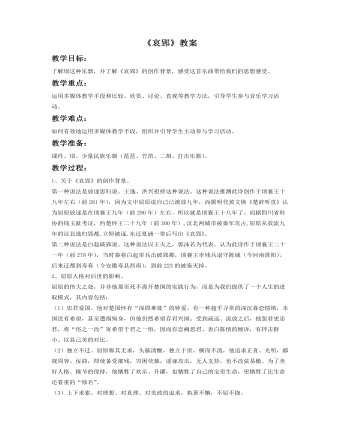
《哀郢》教案
关于《哀郢》的创作背景。第一种说法是放逐思归说。王逸、洪兴祖持这种说法。这种说法推测此诗创作于顷襄王十八年左右(前281年),因为文中屈原说自己已被放九年,而据明代黄文焕《楚辞听直》认为屈原放逐是在顷襄王九年(前290年)左右。所以就是顷襄王十八年了。而据四川省科协的钱玉趾考证,约楚怀王二十九年(前300年),汉北两城市被秦军攻占,屈原从放流九年的汉北逃归郢都,立即被逐,东迁夏浦一带后写出《哀郢》。第二种说法是白起破郢说。这种说法以王夫之,郭沫若为代表。认为此诗作于顷襄王二十一年(前278年),当时秦将白起率兵击破郢都,顷襄王率残兵退守陈城(今河南淮阳)。后来迁都到寿春(今安徽寿县西南),到前223的被秦灭掉。
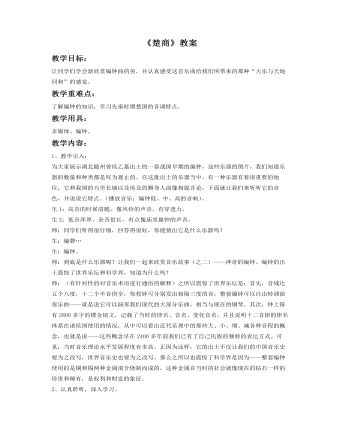
《楚商》教案
之所以震惊了世界乐坛是:首先,音域达五个八度,十二个半音俱全,每枚钟可分别发出相隔三度的音,整套编钟可以自由转调演奏乐曲——就是说它可以演奏我们现代的大部分乐曲,相当与现在的钢琴。其次,钟上铸有2800多字的镂金铭文,记载了当时的律名、音名、变化音名,并且说明十二音律的律名体系在诸侯国使用的情况,从中可以看出近代乐理中的那些大、小、增、减各种音程的概念,也就是说——这些概念早在2400多年前我们已有了自己民族的独特的表达方式。可见,当时音乐理论水平发展程度有多高。正因为这样,它的出土不仅让我们的中国音乐史要为之改写,世界音乐史也要为之改写。那么之所以也震惊了科学界是因为——整套编钟使用的是铜和锡两种金属混合烧制而成的,这种金属在当时的社会就像现在的钻石一样的珍贵和稀有,是权利和财富的象征。
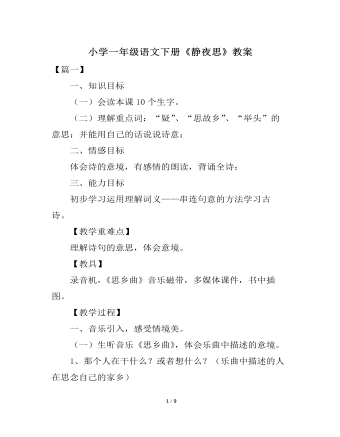
《静夜思》教案
(1)读整行诗。 (2)根据学生提出的问题理解“疑”的意思(怀疑、好像); “霜”(老师哈气在眼镜片上,并解释这是雾水,如果是冰粒,便是霜。霜在秋冬季节形成在地面附近:如房顶、草叶、地面等,堆起来是白色。) (3)说说这两行诗的意思。用上“什么好像是什么”的句式。(明亮的月光照在诗人的床前,好象是铺在地上的白白的霜) (4)朗读,引导。 诗人这样描写,给了你一种什么样的感觉?(冷清) 师描述:今晚,银白色的月光洒在地上,像铺了一层冰冷的霜一样。环境如此冷清,再加上诗人远离亲人的孤独,就更感到冷清了。

